
When was the last time (or the first time) you knowingly ate tallow?
Could you appreciate the flavor? Or did you happen to bite off more than you could chew?
Call me old-fashioned, but tallow is a staple fat in our family diet, along with home-rendered lard.
Not to mention the fact that we also eat plenty of foraged greens, weeds and vegetables from our organic no-dig garden.
Home-rendered fats from beef, pork, goose and duck were once very popular (think back at least 100 years ago) for several good reasons.
First of all, they don’t take any special equipment to process, and they are incredibly easy to store. They can last for several months without refrigeration and they are among the healthiest fats you can get; especially when you are preparing them from grass-fed animals.
I trust that they can become popular once again, once we relearn to appreciate them for what they are.
Eating sustainably is all about finding balance. What works for us, may not be the best diet for you, though it rarely hurts to get back to traditional basics. Tallow being one of them.
Today you are going to find out exactly what you may be missing out on, should you not already be cooking with tallow at home.
We’ll also show you the steps to render your own tallow, so that you can be empowered to live a more self-reliant life.
What is tallow?
In short, tallow is rendered beef fat.
At least that is the case when you go to the butcher and purchase the required cuts for yourself, then simmer the fat down into a liquid (which will harden once chilled) as a replacement for vegetable cooking oils.
If you are buying ready-made tallow, be aware that it may come from other animals as well, such as mutton/sheep and horses.
If you want to keep it simple, start with making your own, because, you know that fat is in fact good for you. I know, the concept of eating fat to get and stay slim seems not only paradoxical, but controversial too. That is a debate for another time and another place, though I encourage you to be open to redefine what is “healthy” based on your own food experiences.
Why use tallow in cooking?
For some of us, in order to get past the “ick” factor, it is wise to find out about the health benefits of consuming tallow before passing judgement. Otherwise, you may never know what you are missing!
It also makes perfect sense to dive into whether or not Crisco and other monoculture seed oils are as healthy as they say. Again, it is up for you to decide.
What you should know before clicking away, is that tallow has many health benefits and is super tasty too. We’ll share some recipes later on, so that you can try it as you cook your next dinner.
Hidden health benefits of tallow
Whether or not you have chosen to follow a keto or carnivore diet, or just happen to fall somewhere in between with a love for all healthy foods, it is good to know that tallow is high in saturated fats, with zero carbohydrates.
Tallow from grass-fed animals is rich in essential nutrients and fat-soluble vitamins such as A, D, E and K.
It also contains choline, which is helping you with your memory and is associated with healthy brain tissue.
Tallow also has beneficial conjugated linoleic acid (which helps to fight fat and build muscle) and stearic acid which is known to repair damaged skin.
When used in cooking, you find the high smoke point of tallow (420°F/220ºC) comes to an advantage, especially when you are grilling or frying.
Now, that you know why you should be eating it, let us show you how to make it.
How to render tallow on the stove
If you are in a lucky situation to raise animals on your farmstead, chances are good that you will be – or become – familiar with the insides of an animal at some point.
Home butchering has long been a way to put meat on the table without having to go any further than your fence line.
In modern times, however, the butcher is here to provide us with the specific parts we need for making the most wonderful dishes.
Tallow, as it is most commonly known, is made from beef fat. More specifically the “leaf fat”, or the mass around the kidneys. It feels a bit waxy on the outside, with a thin layer of paper-like tissue that separates it from the organs.
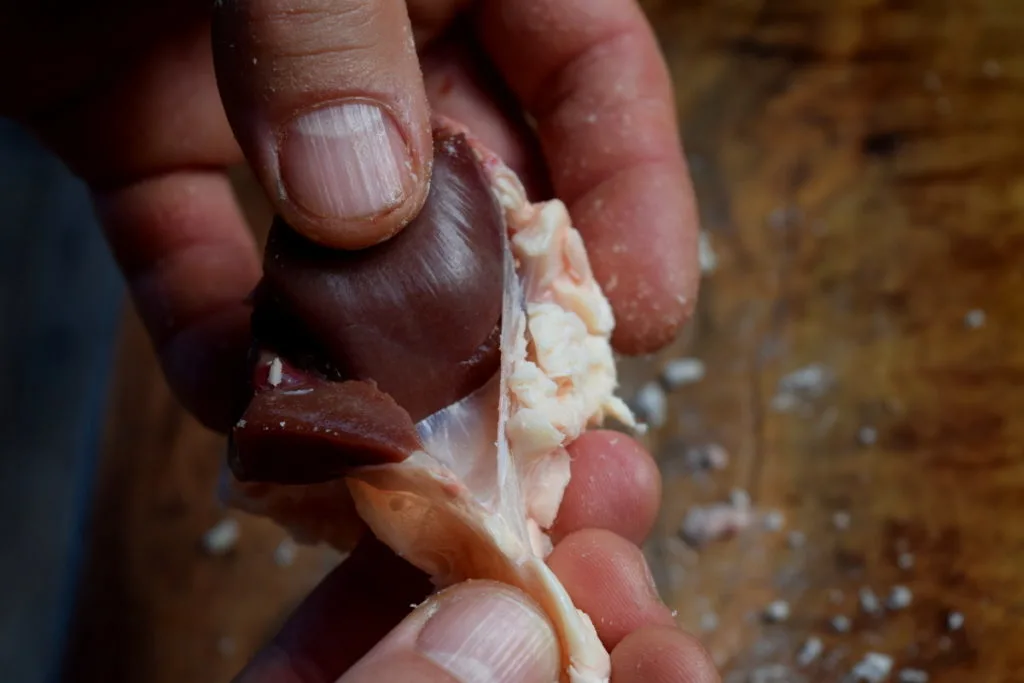
Fat from elsewhere on the body is fine to render as well, though the flavor will be slightly different. More animaly, if you will.
When rendering tallow for our own use, we usually end up cooking down 7.7 lbs. (3.5 kg) at once.
What you need to get started for rendering tallow
There isn’t a lot that you need for rendering tallow:
- grass-fed beef fat
- large stock pot or slow cooker
- jar or pot with lid for storing
- fine wire-mesh strainer – optional
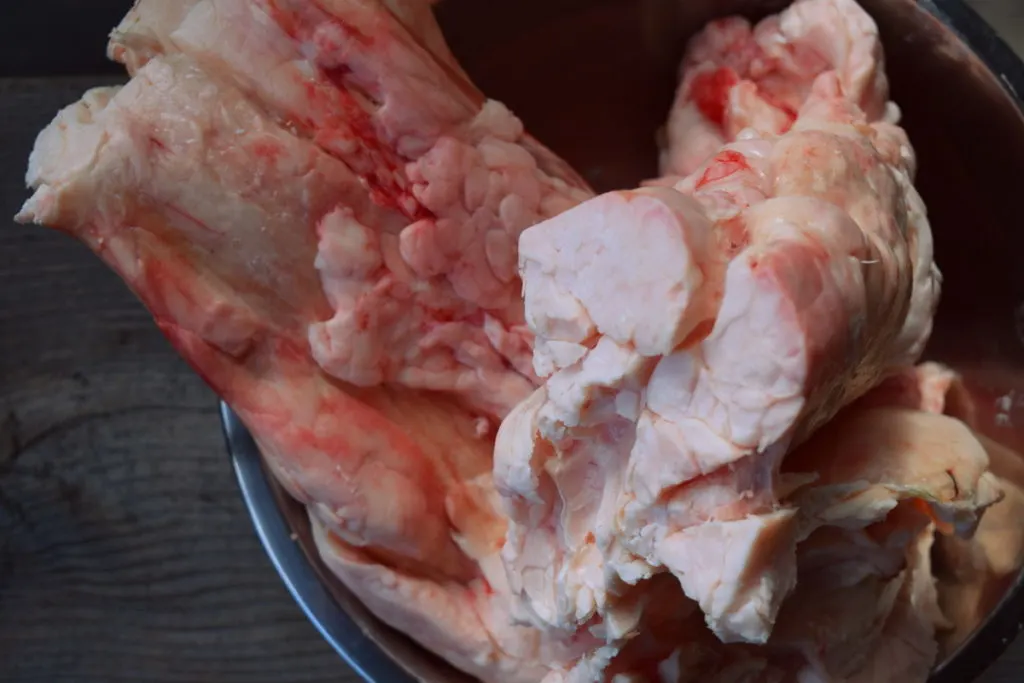
Ask your butcher for as much beef fat as you think you need at once, keeping in mind the size of your biggest cooking pot. Take it home and get chopping!
Step 1: Chopping up the beef fat
Unless you ask your butcher nicely to grind it for you, you will be in charge of cutting your fat into small pieces. Take your time with this task, since it does affect the outcome of your tallow.
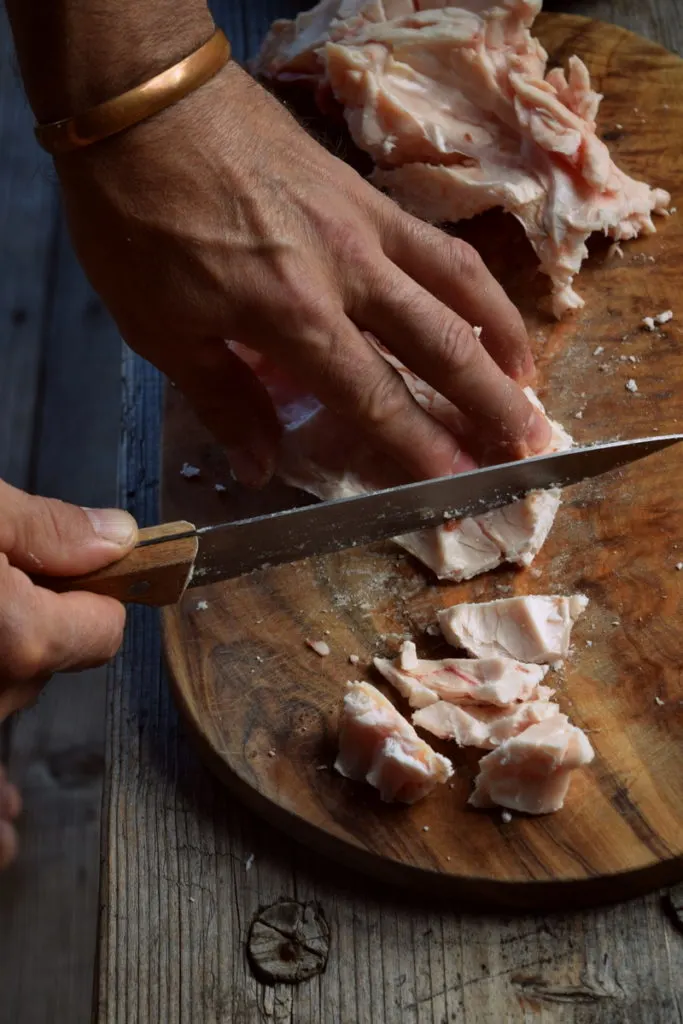
The smaller the pieces are, the faster and more evenly the whole mass will heat up.
When cutting the fat, you don’t want it to be too warm. In fact, the colder it is, the easier it gets to work with. Just not frozen.
As you cut small pieces, be sure to trim off the blood, meat, gristle and other impurities you may find.
You can stop chopping here when you are satisfied with your work.
An optional step would be to grind your fat into a ground meat-type texture with the use of a food processor. It speeds up the rendering process (cooking down), but makes it harder to strain in the end.
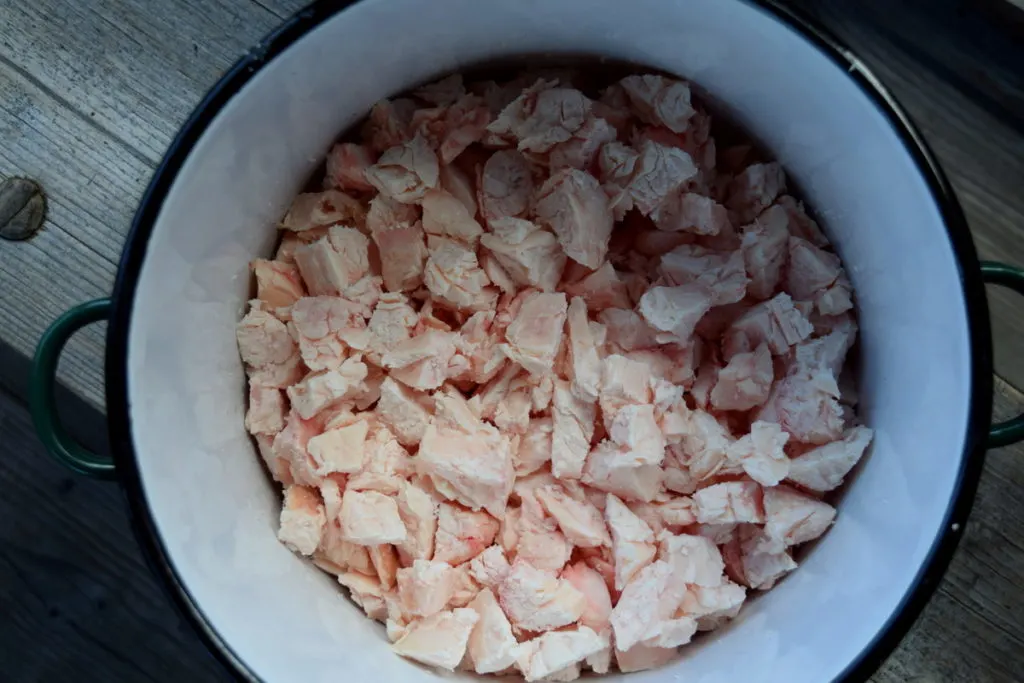
Bottom line, use the tools you have – don’t go out and buy a food processor if you don’t already own one.
Step 2: Cooking down the tallow
Add the beef fat to your cooking pot and begin to melt it down over low heat.
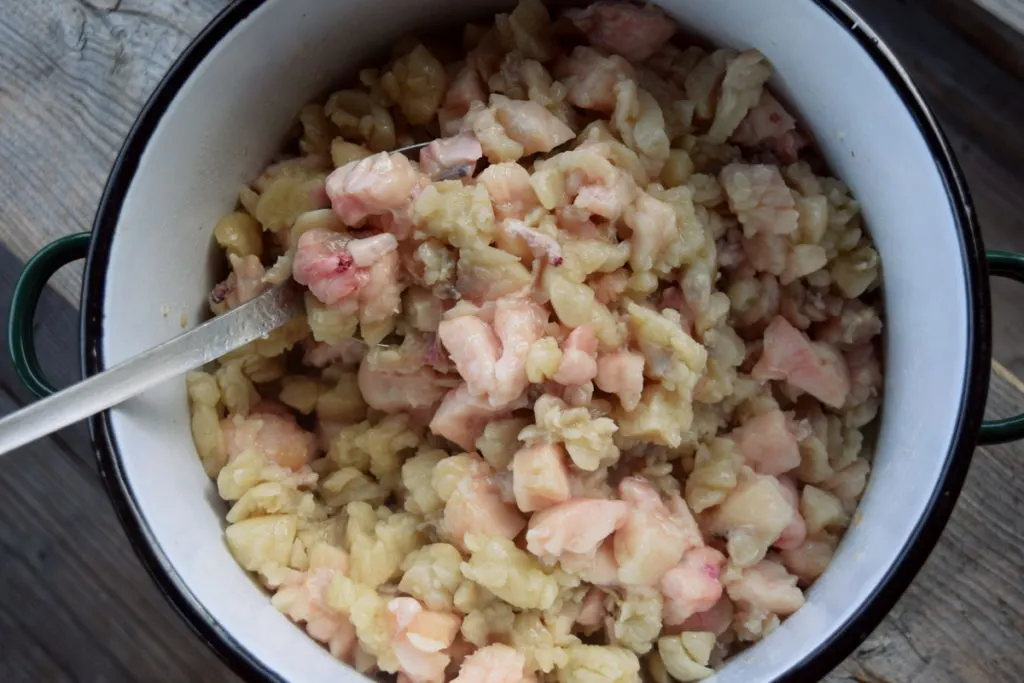
You can also add 1 cup of water at the very beginning to prevent the mass from burning on the bottom of the pot. It will evaporate by the end.
Above all, do not burn the cooking tallow. It will not be nearly as tasty as one cooked long and slow.
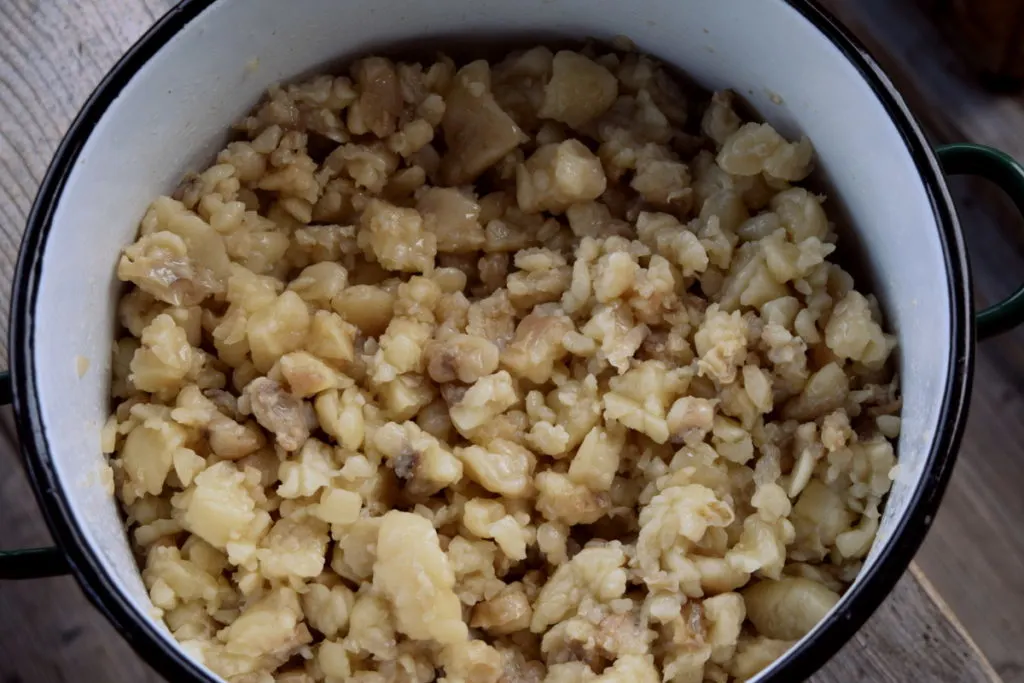
Stir the tallow often, particularly when it is coming to an end. This could take 2 hours or more, depending on how much you are rendering at once.
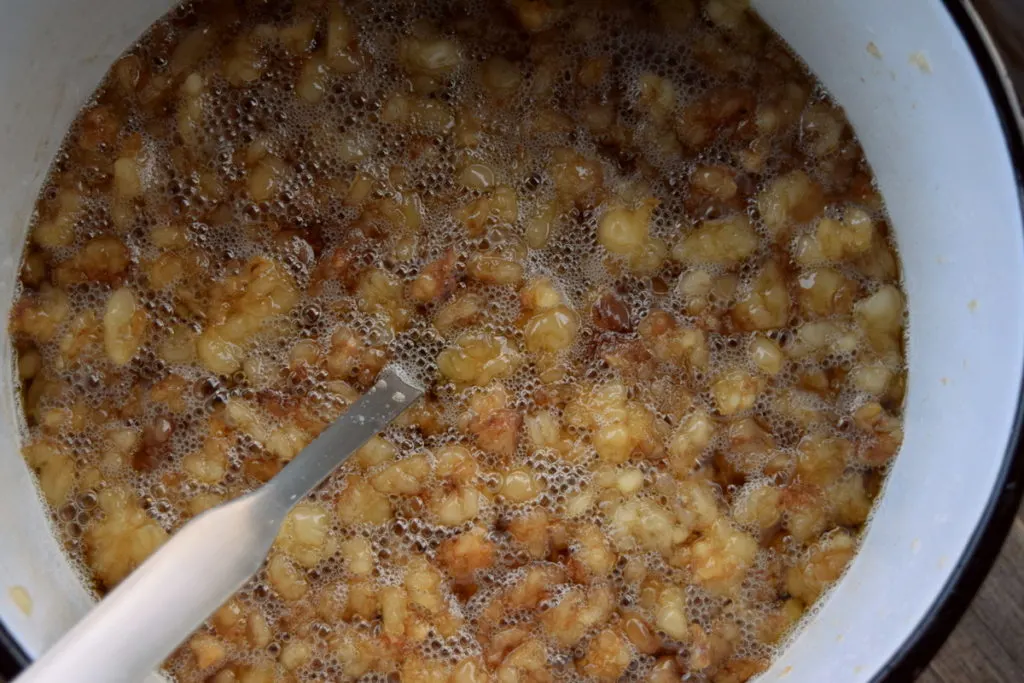
Step 3: Separating the tallow from the rinds
When the tallow is finished cooking, all the fat pieces will now be floating on top of a clear liquid (your home-rendered tallow). Some people call those floaty pieces “impurities” and others store them in a covered bowl for later use. Similar to pork rinds, they can be added to rice dishes or stews to enhance the flavor, at the same time adding vital nutrition.
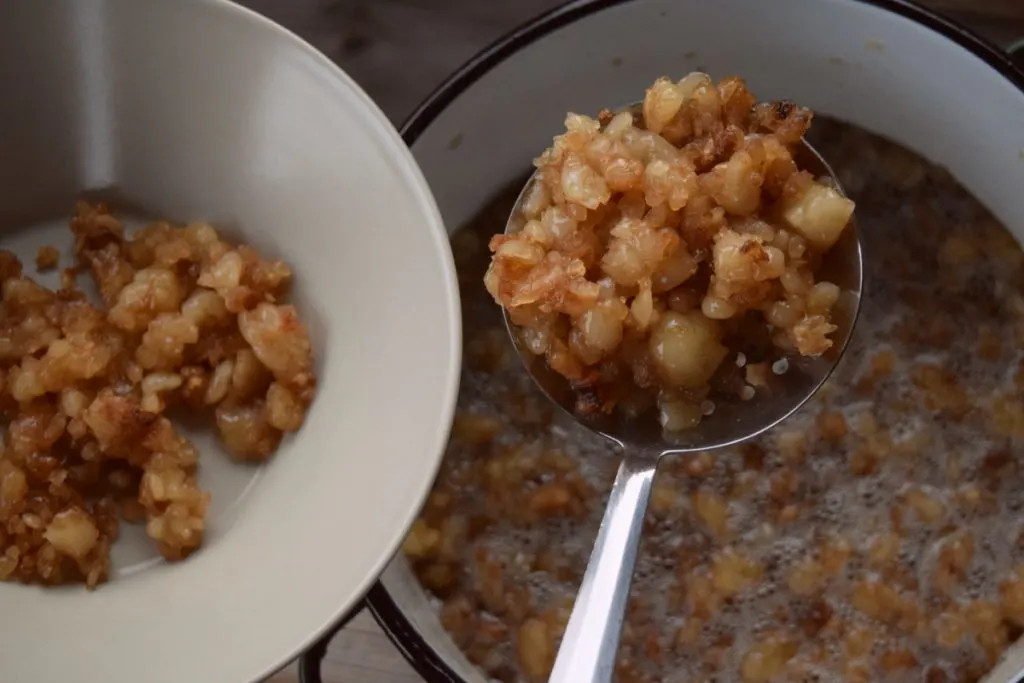
It is more a question of food waste whether you wish to consume them or not. If not for you, then perhaps they can be added to dog food. Whatever the case may be, refrain from putting the impurities on your compost pile, so as not to attract curious animals.
Depending on the size of the leftover fat pieces, you can either use a fine-mesh strainer or cheesecloth to separate the pure tallow from the rest.
Step 4: Storing your home-rendered tallow
Straining directly into a wide-mouth jar is a great way to make less of a mess, at least initially.
Spooning it out of a jar can sometimes be a challenge, though it makes a great storage vessel.
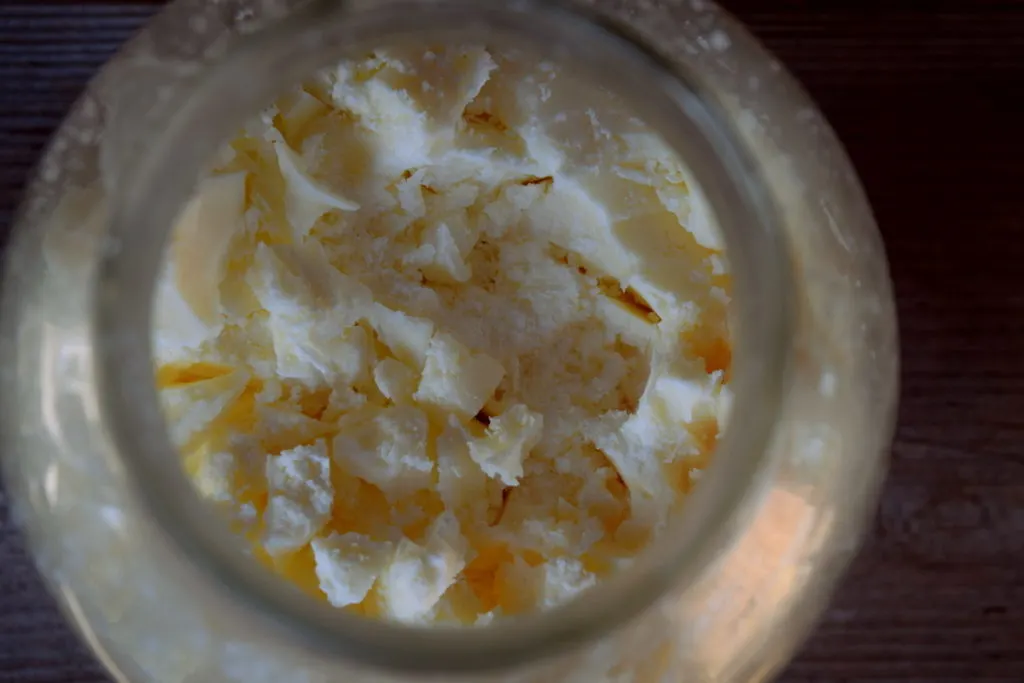
However, you can also line a baking sheet or cake pan with parchment paper, then pour the liquid fat into the pan and allow it to come to room temperature. This method makes the tallow available for easier access as it can be broken or cut into smaller pieces.
At room temperature, tallow will be hard to touch and off-white in color.
Some breeds may impart a yellowish tint, though they will taste similar, as it is with the same Jersey or Guernsey cows’ milk.
Tallow will keep for more than a year at room temperature. Even longer in the fridge or freezer. Despite it being so simple to make, you can render tallow several times throughout the year to always have a fresh supply.
Can I use a slow cooker to render tallow?
Of course you can!
The best way to render tallow is slowly. Keep it on a low temperature and be sure to stir it occasionally, so as not to burn.
Be forewarned, it will smell as you cook it. Emitting an odor that some people may find offensive – it certainly does attract our neighbor’s cats every time! The finished tallow has a pleasant mild beef smell.
Will you like it? That is the question that remains.
Now you get to find out what to do with it.
20+ ways to use tallow
Tallow has a number of practical uses ranging from cooking dinner to greasing your cross-cut saw and waterproofing your hiking boots. We’ll go through some of its uses in detail and list some more, just to keep things interesting and to keep your curiosity growing.
Tallow in cooking
Fries top the list as one of the most enticing ways to eat rendered beef fat.
Handcut fries in tallow
The best fries in the world are cooked in tallow.
If you have already experienced this, then you are among the few who know the best kept secret of making crunchy fries, or chips, as it may be.
With homegrown potatoes, it just gets even better!
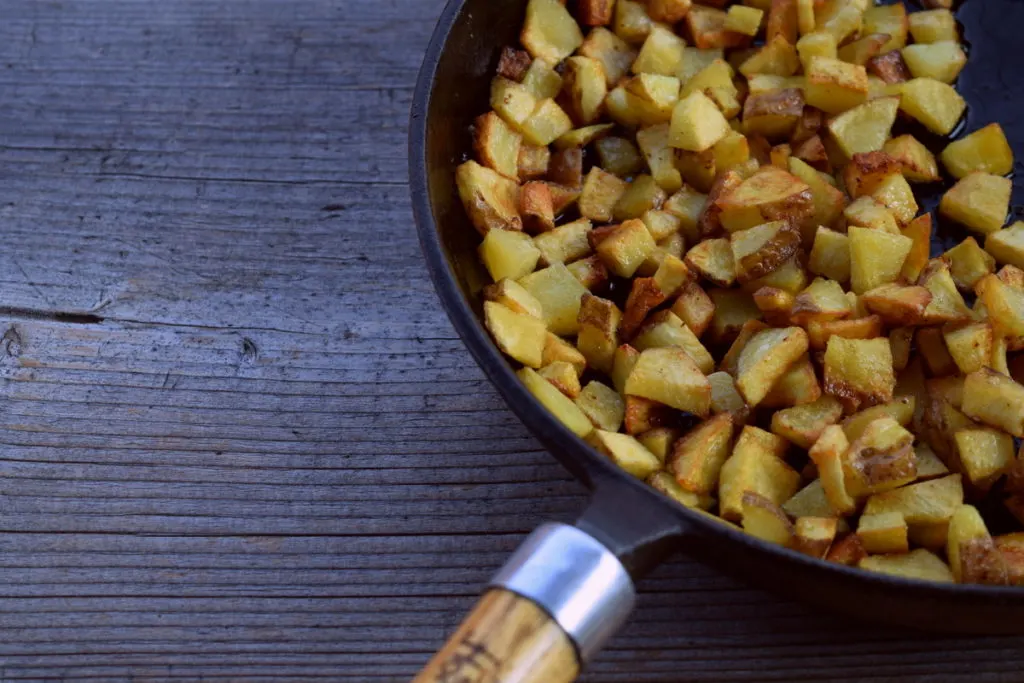
If you don’t have time to soak your fries in water, you can just cut them up and toss them straight into your cast iron pan for a tasty skillet meal of home fries. A 50:50 mixture of tallow and lard is highly recommended.
Tallow pie crust
Like lard, tallow is also delicious when added to pie crusts.
Be sure that it is cold before adding it to the flour and all will be good. Very good.
You can also fry up a flat bread in tallow, for an extra special and extra quick snack.
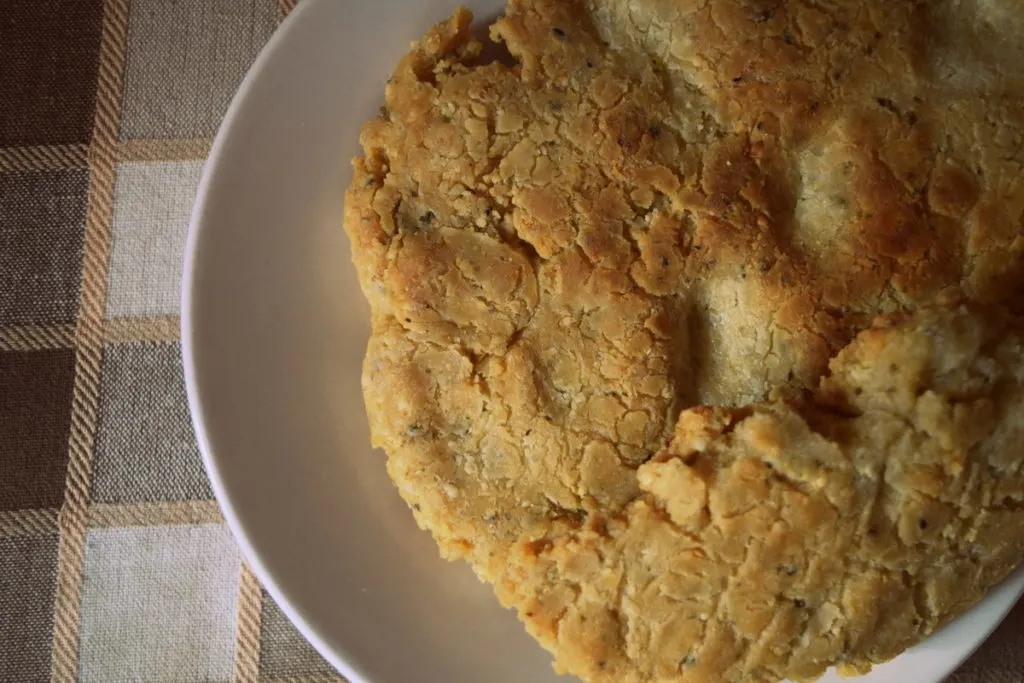
The Perfect Pie Crust Recipe @ Weed ’em & Reap
More recipes that use tallow
Tallow can be substituted for any other vegetable oil that you currently use for frying. Flavorwise, there will be differences. Mouthwateringly tempting differences.
Try using tallow when you make:
- pancakes on the salty side
- fried green tomatoes
- hash browns
- sweet potato fries
- hamburgers
- fried chicken
- onion rings
- omelettes
- sautéed fresh greens and more
If you still have some trepidation about eating it, find someone to share a meal with. Or start using it around your home, and for your body in other ways.
Using tallow for projects
You may be surprised to know that tallow has dozens of brilliant uses. Let’s just go over the standard ones, to pique your curiosity for more.
Tallow birdseed ornaments
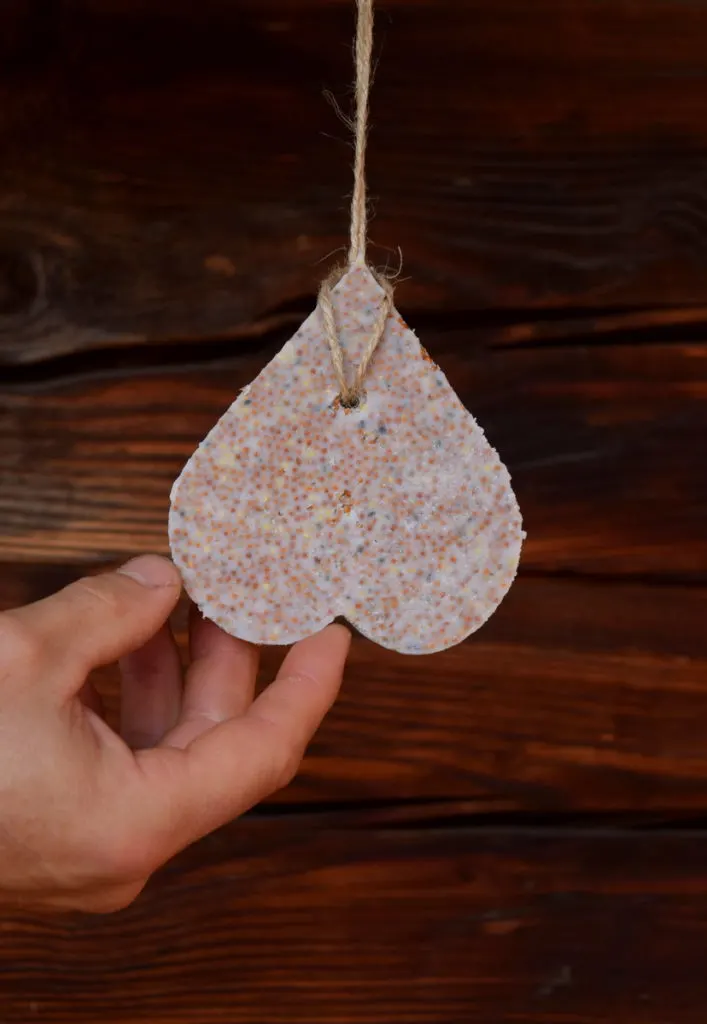
All you need is tallow and birdseed to make these brilliant “bird cookies”.
Tallow soaps
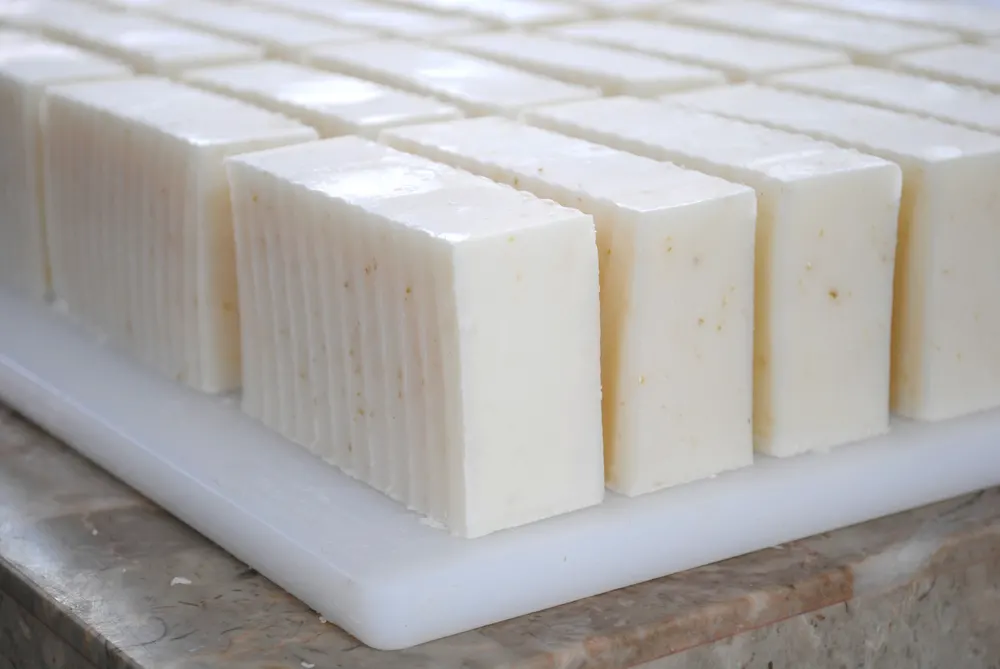
You might be thinking, no, not me. I couldn’t use tallow all over my body, but really you should.
And it couldn’t be easier than mixing tallow, lye, water and essential oils (which are optional) all together to make soap in your crockpot.
Call it an upgrade from your great-grandparents’ soap, I am pretty sure the act of making soap with tallow is timeless.
Get the directions on how to make tallow soap here:
Pure Tallow Soap Recipe | How to Make Soap From Scratch @ Bumblebee Apothecary
Another beautiful homemade hair product to try is a tallow shampoo soap bar. As far as ingredients go, this recipe includes coconut oil, olive oil and castor oil as well as the tallow and lye. Looks like a good one to me!
Homemade skincare products – tallow balm
Remember that we mentioned how tallow is nourishing for your skin.
This DIY tallow balm recipe will not disappoint you.
Nurture your dry hands after a day of working in the garden, apply it generously to your feet at the end of a long day. Gently slather it on sunburnt skin, eczema or diaper rash. It can be your go-to remedy for all sorts of skin ailments.
If you don’t want to make tallow balm for yourself, there are a limited number of artisans selling it online. Search for grass-fed moisturizer and see what comes up near you.
Tallow lip balm
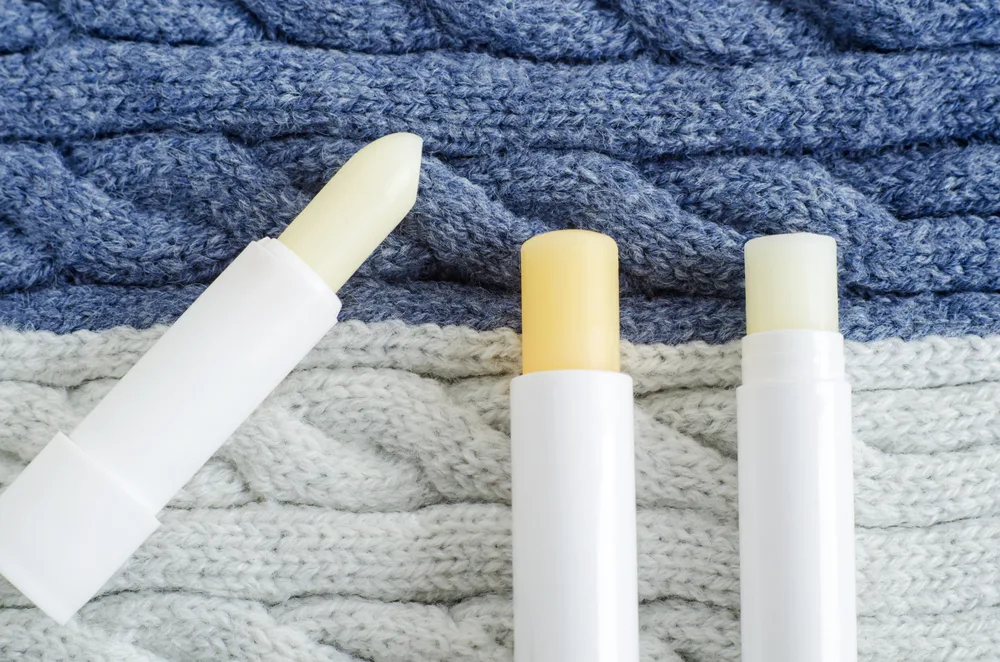
Just as your skin gets dry, so often do your lips get chapped in the windy winter months, while you are out hiking, skiing, or just having a good time.
With just tallow, beeswax and honey you can be on your way to a lovely set of homemade gifts in a matter of minutes.
Tallow Lip Balm Recipe With Honey @ Bumblebee Apothecary
Tallow candles

If you make the assumption that candles made of tallow may not seem as sweet smelling as those made from beeswax; you are right.
Tallow candles may not be winning any kind of awards any time soon, but they are practical in the sense that they are easy to make, and can be used in times of emergency. For a more pleasant scent, simply add some essential oils to the mix.
Before the lights go out, try whipping up a batch of these DIY aromatherapy tallow candles.
Numerous other uses for tallow
Tallow can be also used to:
- season your cast iron pans
- condition wooden cutting boards, spoons, spatulas and other cooking utensils
- grease your dry knees and elbows
- make mustache wax and shaving cream
- waterproof your boots
- treat and condition leather
- lubricate moving parts on machinery and hand tools
- prevent rust
- and much, much more
All things considered, in a survival situation tallow can definitely come in handy. You can render it from just about any grass-fed, grazing animal, plus it supports nose-to-tail eating. It is a by-product that is available after every butchering.
If you intend to use it for cosmetic purposes, you can even filter it 2 or 3 times to get all impurities out.
What could be better than a healthy fat that boosts your immune system, helps to build your bones, increases your memory, flavors your food and is essentially free for the taking? Nothing more than tallow.

Get the famous Rural Sprout newsletter delivered to your inbox.
Including Sunday musings from our editor, Tracey, as well as “What’s Up Wednesday” our roundup of what’s in season and new article updates and alerts.

